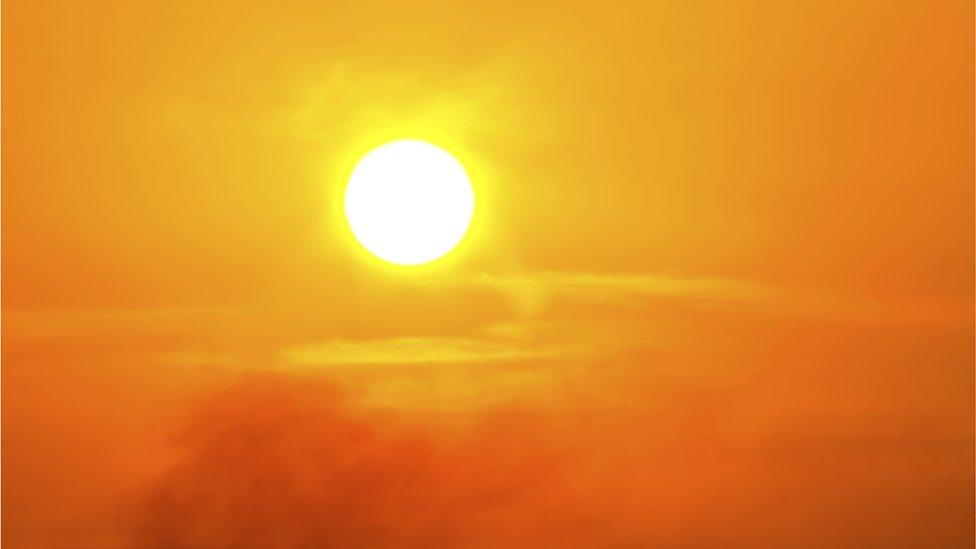Heatwave: Five ways the world is dealing with extreme heat
- Published
- comments

Scientists say extreme heat will become more common around the world
Europe is experiencing record temperatures and this extreme heat is going to become more and more common around the world.
Heatwaves have become more frequent, more intense, and last longer because of human-induced climate change.
Without action to reduce greenhouse gas emissions, temperatures will continue to rise.
While world governments have made promises to cut emissions and tackle climate change, they are also taking more immediate actions to deal with rising temperatures.
Here are some of the ways places around the world are responding and preparing for extreme heat...
Protecting glaciers
The Swiss alps covered by a special blanket to help prevent melting
Each year, the authorities in Switzerland and the European Alps try to prevent the glaciers on the mountains from melting, by covering the slopes with large blankets that reflect sunlight.
The white UV-resistant blankets have been put in position by locals every year since 2009.
Glaciologists - scientists who study glaciers - say the blankets reduce ice melting by between 50 and 70 per cent.
They are made of a heavy-duty fleece material which insulates the ice and reflects back sunlight.
However, because these huge blankets are made from synthetic material, the practice has been criticised by some people because when they decompose, plastic can pollute waterways and the local environment.
Paint it white
A traditional village in Greece
Painting a roof white can reflect sunlight and reduce the temperature inside.
In Ahmedabad City in western India, where summer temperatures can reach as high as 50C, more than 3,000 rooftops were painted with white lime and a special reflective coating.
A 2019 study from Oxford University looked at heatwaves in the city of Birmingham and found cool roofs across the city could reduce peak temperatures by up to 3C during a heatwave.
Many cities in the US have applied the same science to their pavements by painting them white in an attempt to cool them down.
But some experts have warned painting roofs white could have the opposite effect in winter where a reflective roof might mean the need for more heating.
Planting trees
Trees can lower temperatures
Cities can often be a lot hotter than the countryside.
There's a reason for this. Built-up urban areas with tall buildings which are close together make more heat which is then trapped to created a localised warming - an effect named the 'Urban Heat Island'.
One way to deal with this, and tackle climate change, is to plant trees.
Finding a tree to stand under in the heat is a welcome relief but they help cool the environment as well.
Trees, in particular ones with broad, light-reflecting leaves and large canopies, can lower the temperature of buildings and pavements with their shade.
They can also release a water vapour, known as 'evapotranspiration'.
When the sun's rays hit the tree, it causes water to evaporate from the leaves. This cools them down and reduces the amount of energy left to warm the air. Pretty cool!
Urban greening
Instead of a white roof, how about a green one?
Toronto was the first city in North America to pass a green roof law. From 2019, new buildings of a certain size must have roofs covered in plants.
Paris in France recently bought in the same law for commercial buildings.
Paris is also finding other ways to make the city greener. Anyone can apply for a permit to start a garden anywhere at all in the city, so residents can plant on pavements and small areas of public land.
In Singapore, meanwhile, planted balconies, shaded sky gardens and vertical green walls are all used to reduce temperatures and combat pollution.
Cooling water
People use stepping stones to walk across the Cheonggyecheon stream in Seoul
When it's hot, many of us just want to cool down in a paddling pool, a shower or the sea - any sort of water really.
Well that's the same with cities. Open water can decrease the air temperature by evaporation and absorption of heat.
And water that is moving does this better than water that is standing still.
Places that covered up their rivers, like Paris and Seoul in South Korea, are now planning to uncover them.
And, there are more direct ways water can be used to cool people - in Chongqing, China the city has used water misters at bus stops.
These spray clouds of water that cool the air as well as waiting passengers!
- Published29 July
